| Author |
Message |
Adam D. Kent-Isaac

|
 Posted: Wed 20 May, 2009 12:14 am Post subject: What do you call this sort of helmet? Posted: Wed 20 May, 2009 12:14 am Post subject: What do you call this sort of helmet? |
 |
|
It's not often you see a helmet of this kind. It is rounded and the visor, instead of protruding forward in the manner of most close helms, is flush with the round shape of the helmet. It is perforated with many holes all over for viewing, rather than one or two slits.

(Robert Macpherson)

An old painting of La Hire shows something similar:
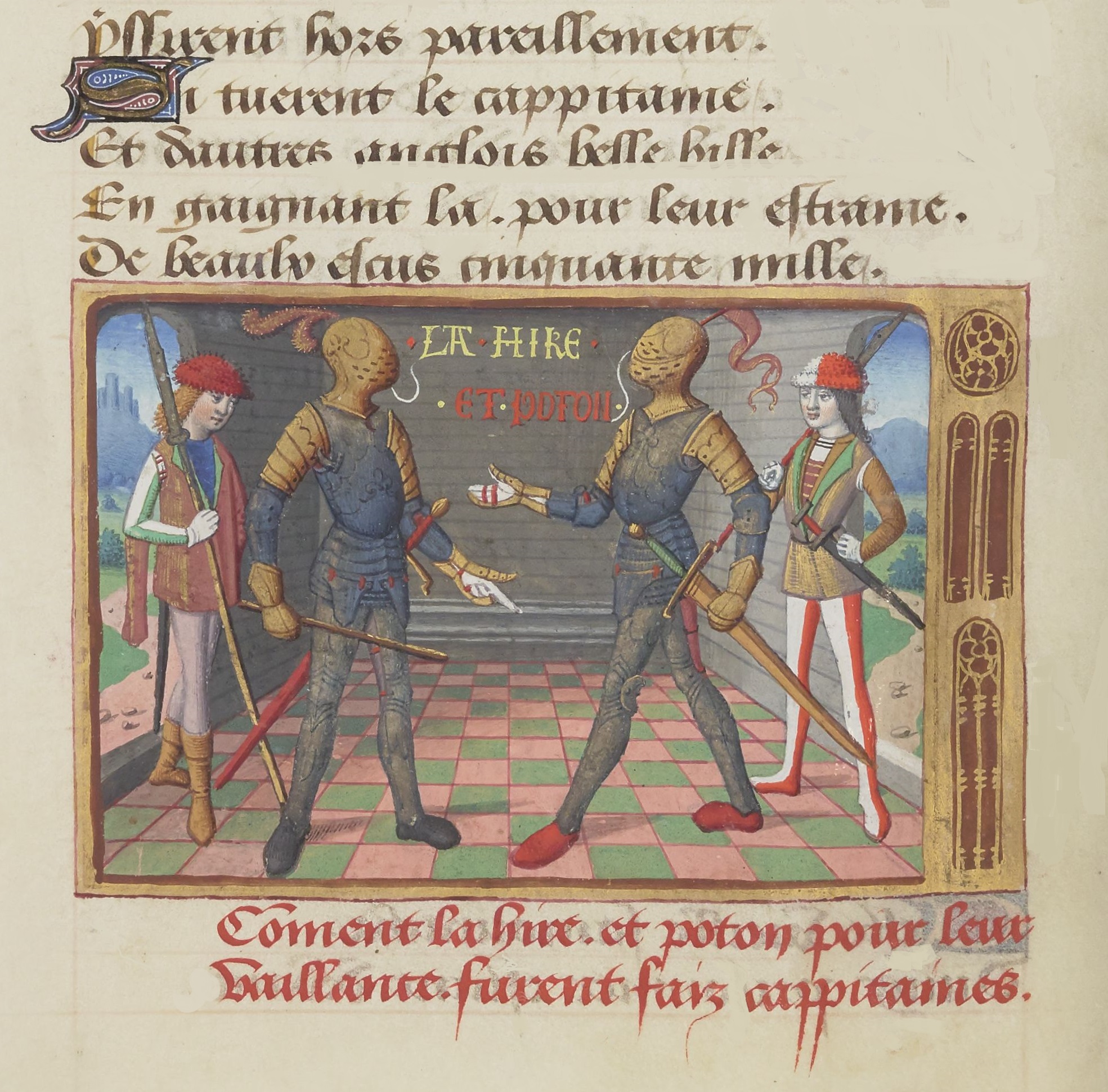
What is the official term for this? Thank you very much in advance for the help.[/url]
Pastime With Good Company
|
|
  |
 |
|
Gabriele Becattini
|
 Posted: Wed 20 May, 2009 2:40 am Post subject: Posted: Wed 20 May, 2009 2:40 am Post subject: |
 |
|
|
i guess that it's a great bascinet, it was popular than armet in germany till the first half of the XVth century and after it was common for foot combat in turney, the armour of Henry VIII for the field of gold cloth in the 1520s had a similar helm
|
|
  |
 |
Adam D. Kent-Isaac

|
 Posted: Wed 20 May, 2009 5:05 pm Post subject: Posted: Wed 20 May, 2009 5:05 pm Post subject: |
 |
|
It hasn't really got the characteristics of a bascinet; it doesn't have a pointed top and the bottom of the helmet seems to be completely enclosed. Wouldn't it rather be a close helm with a rounded and perforated visor?
Now here is Henry's armor for the Field of the Cloth of Gold. It has got a bellows type visor rather than the smooth one pictured in the above images. There is one row of perforations in the visor but all the rest of the folds have slits.
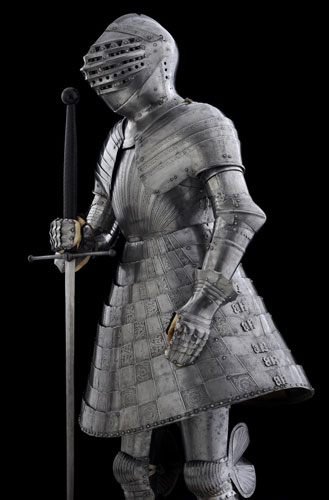
Pastime With Good Company
|
|
  |
 |
Chad Arnow
myArmoury Team


|
 Posted: Wed 20 May, 2009 5:15 pm Post subject: Posted: Wed 20 May, 2009 5:15 pm Post subject: |
 |
|
Great bascinets often have little to do with 14th century bascinets. Some of the great bascinets shown here look like relatives of 14th century bascinets, as they have pointy crowns. But a number do not like much like earlier bascinets.
This helm is often called a great bascinet:
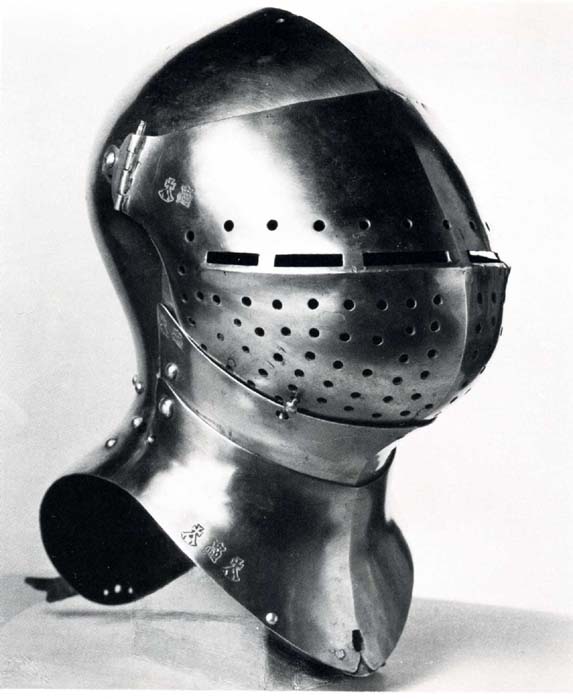
I think great bascinet can be a workable term. Bycoque (French) or Bycocket (English) is another term. Here's a helm from the Deutsches Historisches Museum classifed as a Bycoque:


ChadA
http://chadarnow.com/
|
|
    |
 |
Adam D. Kent-Isaac

|
 Posted: Wed 20 May, 2009 5:33 pm Post subject: Posted: Wed 20 May, 2009 5:33 pm Post subject: |
 |
|
Wow, I have never seen anything like that second one. It looks almost surreal. The first picture looks fairly similar to the one depicted in the old painting of La Hire.
Pastime With Good Company
|
|
  |
 |
Jared Smith

|
 Posted: Wed 20 May, 2009 6:43 pm Post subject: Posted: Wed 20 May, 2009 6:43 pm Post subject: |
 |
|
I had thought helmets of this form were termed close helmets? (After the idea that the shape tightly conforms to the shape of the wearer's head, in addition to being an armet / with movable visor pretty much necessary to putting one on.) I suspect this is a modern convention, but it seems to "fit".
Absence of evidence is not necessarily evidence of absence!
|
|
  |
 |
Chad Arnow
myArmoury Team


|
 Posted: Wed 20 May, 2009 7:24 pm Post subject: Posted: Wed 20 May, 2009 7:24 pm Post subject: |
 |
|
Well, the bycoque I posted isn't a close helmet. Close helmets have visors, bevors, etc., that rotate on one pivot. An armet has a pivoting visor, but the cheek pieces are individually hinged, usually at the sides, and close in the front.
So some of those helms are close helms (the one in the original post), and the bycoque is more like an armet. I still think great bascinet or bycocket/bycoque work for some of these hard-to-classify helms.

ChadA
http://chadarnow.com/
|
|
    |
 |
Jared Smith

|
 Posted: Wed 20 May, 2009 8:09 pm Post subject: Posted: Wed 20 May, 2009 8:09 pm Post subject: |
 |
|
I am wondering by whom or where these are being called bycocket or bycoque? In the era of the bascinet (14th century, obtuse point at rear top consistent with our feature article) these were your classic robin hood style hats. I am not saying that modern authors are not using the term to describe helmets with high ridges, just that the attached illustrates what the word actually meant at the time of the bascinet.
 Attachment: 4.56 KB Attachment: 4.56 KB
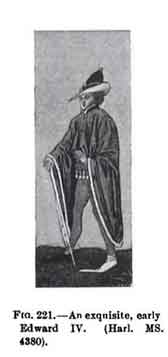
Absence of evidence is not necessarily evidence of absence!
|
|
  |
 |
Brian Hook

|
 Posted: Wed 20 May, 2009 10:39 pm Post subject: Posted: Wed 20 May, 2009 10:39 pm Post subject: |
 |
|
Chad,
Do you have the link to the information page on the second great bascinet you posted? I can't seem to find it in dmn object search.
|
|
  |
 |
Adam D. Kent-Isaac

|
 Posted: Wed 20 May, 2009 11:21 pm Post subject: Posted: Wed 20 May, 2009 11:21 pm Post subject: |
 |
|
That thing is downright creepy and alien-looking.
Pastime With Good Company
|
|
  |
 |
|
Gabriele Becattini
|
 Posted: Thu 21 May, 2009 4:10 am Post subject: Posted: Thu 21 May, 2009 4:10 am Post subject: |
 |
|
|
if you can take a look at "Tudor Knight" by Christopher Gravett, inside you can find the two armour made for Henry VIII for the field of gold Clot plus another helm belonging to him for foot combat, Mr. Gravett call all this Helms great bascinet. the pics posted by Chad are two good example of german style great bascinet the first if ai remember well is a german export model made in northern italy.
|
|
  |
 |
Chad Arnow
myArmoury Team


|
 Posted: Thu 21 May, 2009 5:33 am Post subject: Posted: Thu 21 May, 2009 5:33 am Post subject: |
 |
|
| Jared Smith wrote: | | I am wondering by whom or where these are being called bycocket or bycoque? In the era of the bascinet (14th century, obtuse point at rear top consistent with our feature article) these were your classic robin hood style hats. I am not saying that modern authors are not using the term to describe helmets with high ridges, just that the attached illustrates what the word actually meant at the time of the bascinet. |
Howard Curtis uses the term in his book on helmets. The book Europiasche Helme use the term as well. I believe there are others. I'm not just making that up. 

ChadA
http://chadarnow.com/
|
|
    |
 |
Chad Arnow
myArmoury Team


|
|
    |
 |
Brian Hook

|
 Posted: Thu 21 May, 2009 1:31 pm Post subject: Posted: Thu 21 May, 2009 1:31 pm Post subject: |
 |
|
Thanks for the link Chad, I've had that picture sitting my armour folder for quite some time now as "Kat54.jpg" and could not for the life of me remember how or where I got it. This helm is definitely on the list of helms I must have reproduced. 
|
|
  |
 |
|
Jean-Carle Hudon
|
 Posted: Thu 21 May, 2009 4:41 pm Post subject: bicoque (or biquoque) or... Posted: Thu 21 May, 2009 4:41 pm Post subject: bicoque (or biquoque) or... |
 |
|
Viollet-le-Duc, the architect and medieval revivalist of the XIX th century in France also lists this style as a bicoque and quotes a primary source dated 1446 which does the same. Now as you know, 1446 is before the beginning of English language laws, and that period's version of the northern french language was still commonly used in the english upper classes, those who would use the armor of the day. I think it is safe to assume that's how the crossover into the anglo-saxom idiom came about.... So Chad is certainly not making anything up....he's keeping that talent in reserve for the day he decides to write historical fantasy novels... as for the spelling, well it varies, but that is normal as we are referring to a time when the great national languages of Europe were evolving and did not have set rules. JC
Bon coeur et bon bras
|
|
  |
 |
Jared Smith

|
 Posted: Thu 21 May, 2009 7:22 pm Post subject: Posted: Thu 21 May, 2009 7:22 pm Post subject: |
 |
|
I apologize sincerely to Chad if it sounds as though I accused him of making something up! It has been a few years, but as I recall it, Viollet le Duc translated sallet with bevor and visor as a bassinet. It is a pretty broad interpretation, and a 19th century one. I am curious if the above context is from the same text that actually illustrates the German style sallet, or another one? I do not see it while briefly scanning the Dictionanaire Raisonne Mobilier Francais.
At any rate, there was a distinctly 14th century fashion in head wear (helmets, hats, etc) in which the oblique shape was prominent, and many of these terms were specifically used in period. To be truthful, it is my least favorite form, so I would prefer to separate it rather than call everything afterward that also enclosed the head after it.
Absence of evidence is not necessarily evidence of absence!
|
|
  |
 |
|
Jean-Carle Hudon
|
 Posted: Fri 22 May, 2009 3:24 pm Post subject: viollet-le-duc Posted: Fri 22 May, 2009 3:24 pm Post subject: viollet-le-duc |
 |
|
Jared,
no, it is taken from his Encyclopédie Medievale at p. 252. As for the sallets, they can be seen p.426 through 430, under ''salade'', which is most probably at the root of ''sallet'' in the english language, the bevor being la ''baviere''. As for confoundinga sallet with bevor with a ''bacinet'', on the contrary he writes (p.240, 3rd paragraph) thatmail would be attached to a bassinet, but not to a sallet nor an armet, and he shows an evolution in the bassinet where mail is put aside. In his opinion thsi results in a transition piece between bassinet and armet. The visor in that transition piece attaches to an articulated 'gorgerin-colletin'', some form of gorget, rendering mail superfluous.
The style that VLD acknowleges as being german can be seen on p.427, fig. 7, when he adds that french men at arms would wear italian and german products indiscriminately, out of '' les fabriques de Vienne ou Nuremberg...)
Is your book in french or in english? JC
Bon coeur et bon bras
|
|
  |
 |
Jared Smith

|
 Posted: Fri 22 May, 2009 5:30 pm Post subject: Re: viollet-le-duc Posted: Fri 22 May, 2009 5:30 pm Post subject: Re: viollet-le-duc |
 |
|
| Jean-Carle Hudon wrote: |
Is your book in french or in english? JC |
What I have is in English, and have seen fragments of other works of his in English. His illustrations and your ability to describe in well translated English would be greatly appreciated by me, if not many others here. Would you mind posting some photos of his sketches?
Absence of evidence is not necessarily evidence of absence!
|
|
  |
 |
Maurizio D'Angelo

|
 Posted: Fri 22 May, 2009 6:16 pm Post subject: Posted: Fri 22 May, 2009 6:16 pm Post subject: |
 |
|
| Gabriele Becattini wrote: | | if you can take a look at "Tudor Knight" by Christopher Gravett, inside you can find the two armour made for Henry VIII for the field of gold Clot plus another helm belonging to him for foot combat, Mr. Gravett call all this Helms great bascinet. the pics posted by Chad are two good example of german style great bascinet the first if ai remember well is a german export model made in northern italy. |
in the first pictures of Chad post
manufacturer: Antonio Misaglia - Milan - Italy. armor for men of arms. "french"
Armor of Fredrich I, Elector Palatine - Vienna
here the full armor
 Attachment: 85.6 KB Attachment: 85.6 KB
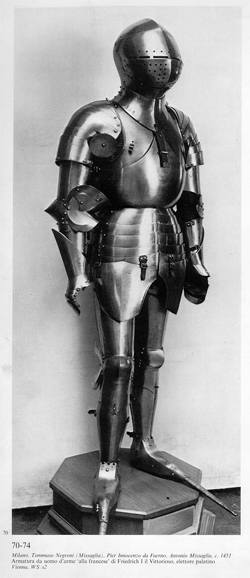
|
|
   |
 |
|
|

